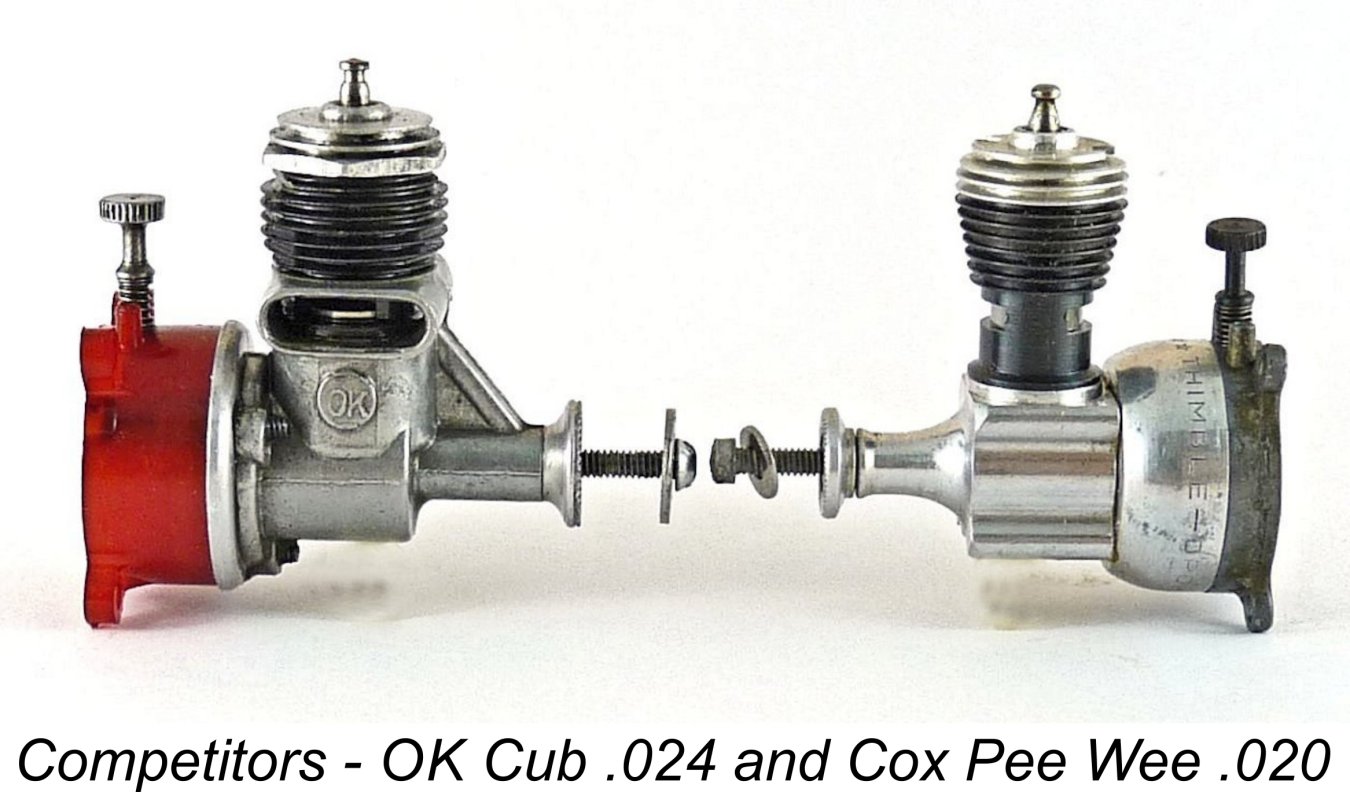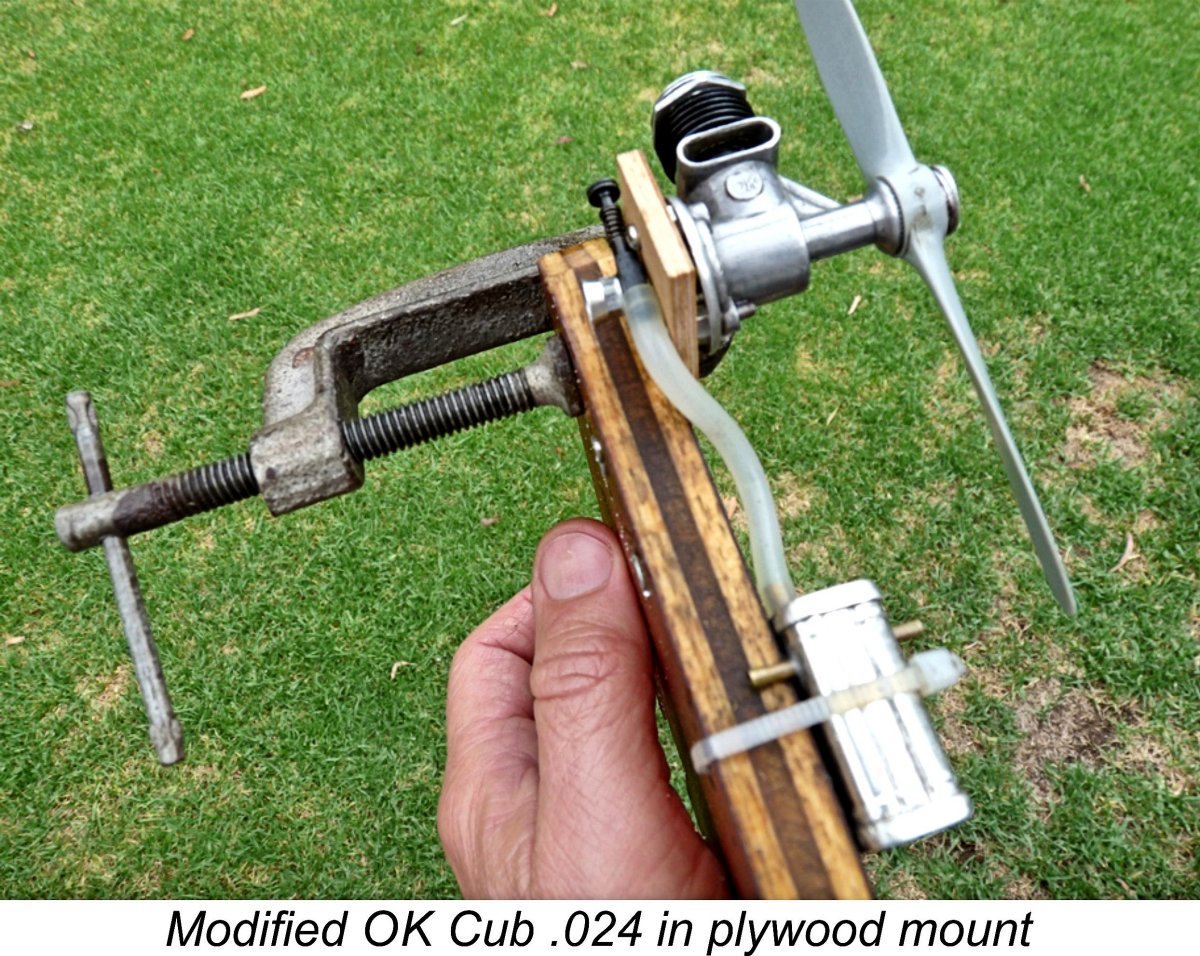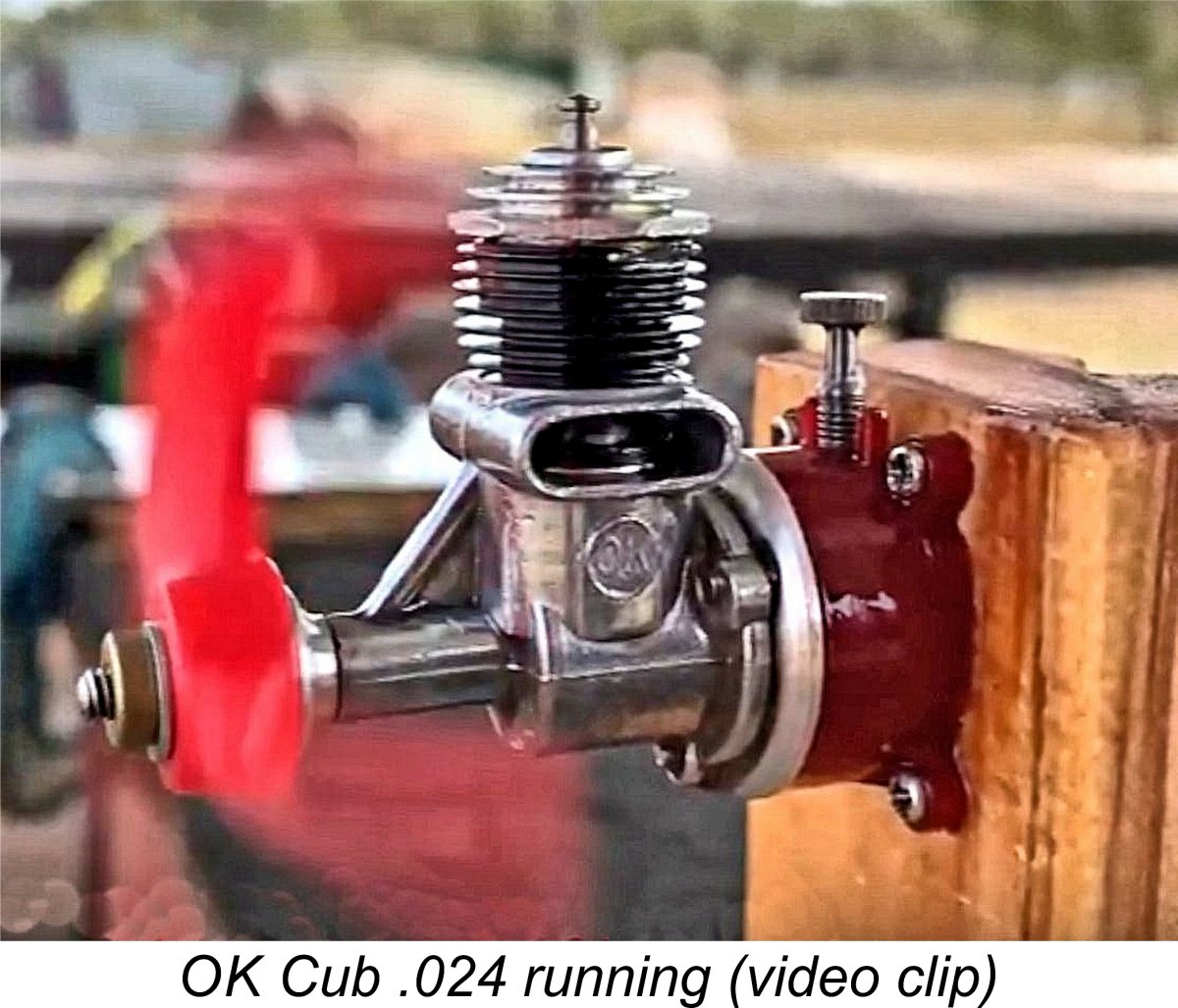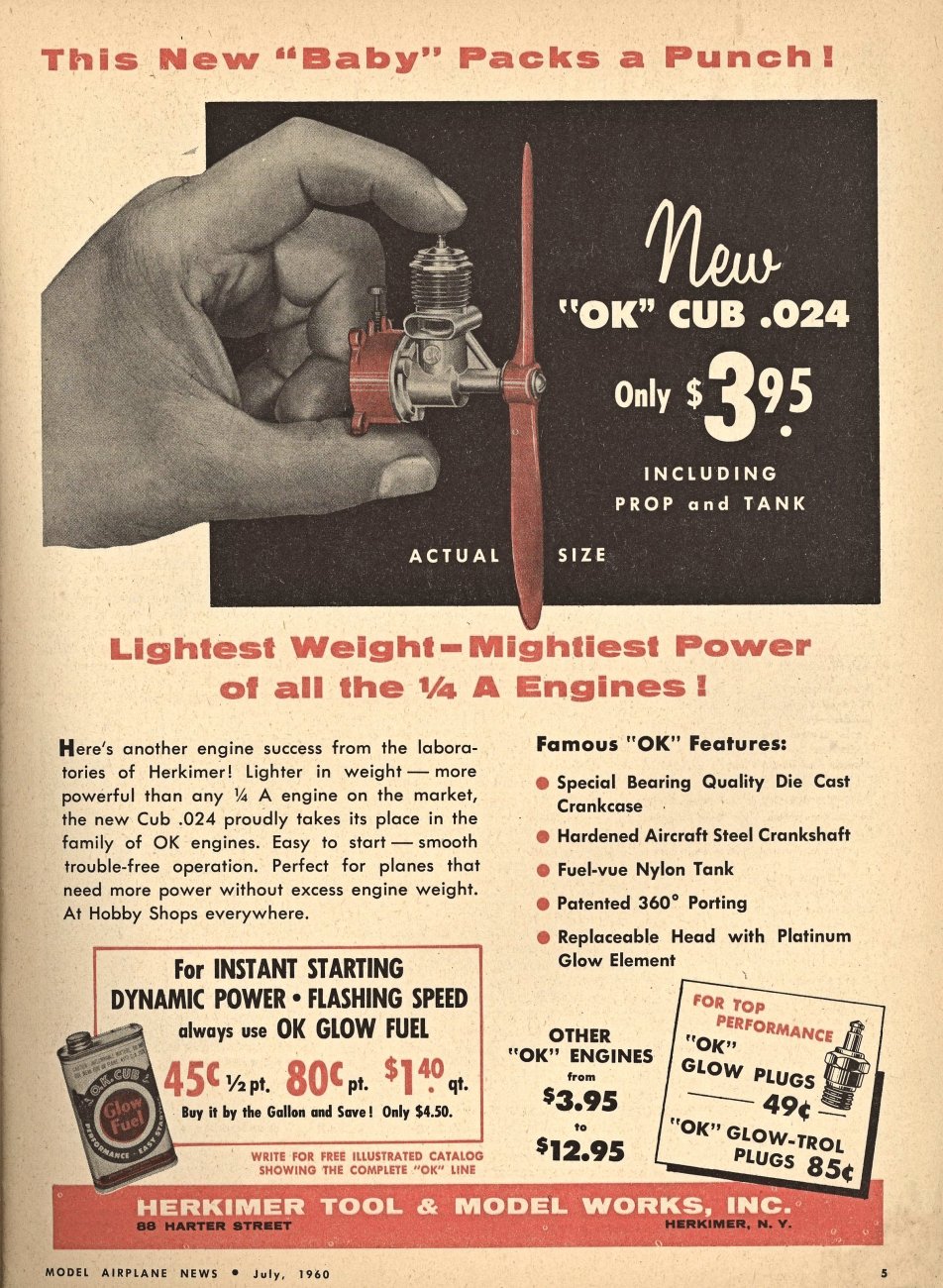
|
|
Fun with the OK Cub .024 By Maris Dislers
Smallest of the Herkimer company’s glow-plug range, the Cub .024 had bore and stroke measurements of 0.320 in. (8.13 mm) and 0.310 in. (7.87 mm) respectively for an actual calculated displacement of 0.249 cuin. (0.409 cc). Its design mixes the twin exhaust stack arrangement of the largest OK models, the 29/35 designs, with the updated design features of the OK Cub .049 and .060 variants introduced in 1958. These included Cox-style cylinder porting, reed valve induction and a head with integral glow element. Those .049 and .060 engines are well regarded for their increased power over the earlier Cubs, yet the Cub .024 seems almost forgotten apart from vague echoing memories of a somewhat sub-standard performance. The contemporary (and slightly smaller) Cox Pee Wee .020 is far better remembered today.
Aero versions were supplied with an OK 5x3 plastic propeller. The 1961 aero version had an added cup-shaped flywheel mounted behind the prop “to help performance” (quoting Tim Dannels' "American Model Engine Encyclopedia"). Then again, these might simply be engines from the OK CADET tethered model airplane, the advert for which says “Nose-balanced for wheels-down landings”. Could the "flywheel" have been nothing more than ballast to obtain a decent CG location?
As an experiment, the integral fuel tank was removed, after which a Cox TD .020 venturi and needle assembly were fitted directly to the backplate’s intake tube, along with a simple plywood mount. Results indicated much improved mixture delivery and control, yielding a steady 12,000 rpm with an APC 5x3 prop and 14,000 with a Graupner 5x2 airscrew. Nowhere near the reported 16,000 rpm from a factory 5x3 propeller noted in the review of the OK Cub .024 which appeared in the August 1960 issue of “American Modeller” – the only published review to my knowledge. Then again, the reviewer also reported an identical rpm figure with a 4.5 x 2.5 propeller, which suggests that the OK 5x3 prop actually had significantly less than its nominal 3 inches of pitch. Having previously tested an OK Cub .024, Don Howie recommended the use of 30% nitromethane fuel. We replaced the original fuel tank and ran further tests with that fuel formula, confirming improved consistency. Running was somewhat unsteady with the 5x3, but better with smaller props, plus worthwhile rpm gains. Basically, as speed went up, consistency improved. The spot power and torque values in the table below are somewhat approximate, as it’s very difficult to establish precise torque absorption factors when dealing with tiny power levels and ultra-light loads.
Power appears to be more or less even at moderate speeds in the 13,000 - 15,000 rpm range, with torque dropping a little as rpm go up. The notable Cox propeller result came as a very pleasant surprise, largely due to the way in which this example of the engine suddenly displayed smooth running and effective needle response. Chalk and cheese compared with any other prop tried! It would appear that the induction arrangements are more or less optimized for very high speeds. A final spot check with the 10% nitro fuel gave fairly dependable running around 16,000 rpm with the Cox prop. This engine clearly likes its nitro!
The Cox Pee Wee was the subject of no fewer than 3 published tests, all of which may be perused on the Sceptre Flight website. The results were amazingly consistent between the three tests, averaging around 0.036 BHP at between 18,000 and 18,500 rpm. The little Cub clearly came close to matching these figures. The Cub .024’s carburettor design is very similar to that of the Pee Wee and Cox’s .049 Bees (with tank). All exhibit minimal choke size at the rear air inlet point and an induction tube which diverges towards the reed valve. Mixture is delivered via a space below the needle valve assembly, mounted near the back. In my experience, this is the least effective design element of those engines. Cox Bees run more consistently and reliably with the alternative plastic back plate having the traditional spraybar-through-intake aperture. Our experiment with Cox TD .020 parts indicated that improved carburetion would also benefit the little Cub’s broader performance envelope. Yet with a suitable combination of fuel and propeller load, the standard engine runs very well indeed provided that it’s kept within a relatively confined “Goldilocks” speed range, which coincides conveniently with the peak power zone. Something that the engine’s reputation suggests did not occur often enough. Perhaps people consistently over-propped the little beastie ............ Although this test didn’t exactly rehabilitate the little Cub .024, it did suggest that the engine deserves to be remembered a little more positively than it generally has been in the past! All in all, a fun experiment! ____________________________________ Article © Maris Dislers, Glandore, South Australia First published February 2020
|
|||
| |
 The OK Cub .024 glow-plug motor of 1960 was the last all-new engine design to be released by the long-established Herkimer Tool and Model Works Inc. of Herkimer, N.Y., USA. The only later product was the revised 1961 variant of the OK CO
The OK Cub .024 glow-plug motor of 1960 was the last all-new engine design to be released by the long-established Herkimer Tool and Model Works Inc. of Herkimer, N.Y., USA. The only later product was the revised 1961 variant of the OK CO Apart from being offered for aircraft use, Cub .024s powered the company’s OK CUB CART, a tethered model go-cart with the engine mounted transversely at the rear and fitted with a flywheel and spur gear driving the rear axle. They were also used in the company's CADET tethered model airplane.
Apart from being offered for aircraft use, Cub .024s powered the company’s OK CUB CART, a tethered model go-cart with the engine mounted transversely at the rear and fitted with a flywheel and spur gear driving the rear axle. They were also used in the company's CADET tethered model airplane.  We decided to have some fun checking out the Cub .024 for ourselves. Our test engine (thanks to Dave Acton) was in very good shape aside from the reed, which was creased and did not seal effectively. A mylar reed intended for the Cox Pee Wee .020 fits well and worked fine. However, initial runs using a fuel with 10% nitromethane and propellers ranging from 5.7x3 to 5x2 displayed erratic running despite careful needle adjustment, much as seen in
We decided to have some fun checking out the Cub .024 for ourselves. Our test engine (thanks to Dave Acton) was in very good shape aside from the reed, which was creased and did not seal effectively. A mylar reed intended for the Cox Pee Wee .020 fits well and worked fine. However, initial runs using a fuel with 10% nitromethane and propellers ranging from 5.7x3 to 5x2 displayed erratic running despite careful needle adjustment, much as seen in 
 What about Herkimer’s claim in the attached advertisement from the July 1960 issue of "Model Airplane News"? The advertisement cites the .024 Cub as having the “Lightest Weight – Mightiest Power of all the ¼A engines”. A true statement when the Cub is compared with the old K&B Infant .020, but at 25.9 grams it’s heavier than the 1958 model Cox Pee Wee .020 (21.8 g) and needs the right propeller and fuel to approach the Cox for power output.
What about Herkimer’s claim in the attached advertisement from the July 1960 issue of "Model Airplane News"? The advertisement cites the .024 Cub as having the “Lightest Weight – Mightiest Power of all the ¼A engines”. A true statement when the Cub is compared with the old K&B Infant .020, but at 25.9 grams it’s heavier than the 1958 model Cox Pee Wee .020 (21.8 g) and needs the right propeller and fuel to approach the Cox for power output.